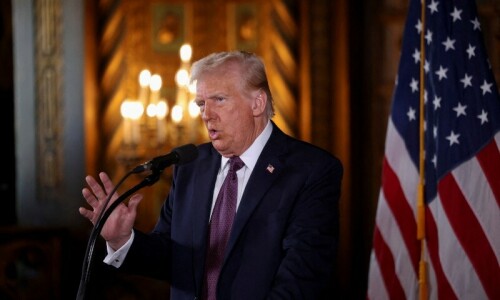 KARACHI, Sept 9: In its latest survey on noise pollution, the Sindh Environmental Protection Agency (Sepa) has found the vehicular traffic-induced noise in the city at an alarmingly high level, necessitating some regulatory measures to reduce people’s exposure to such noise.
KARACHI, Sept 9: In its latest survey on noise pollution, the Sindh Environmental Protection Agency (Sepa) has found the vehicular traffic-induced noise in the city at an alarmingly high level, necessitating some regulatory measures to reduce people’s exposure to such noise.
Experts say that increased noise pollution makes a direct impact on human health.
Sepa’s survey revealed that many of the places in the city had become noisier with a vehicular traffic noise level beyond 85 dB (decibels). The generation of noise from 40-60 dB is considered of a moderate level.
The highest noise generating source, according to Sepa’s data, is the fire-engine siren, generating noise at a level of 130 dB, followed by an ambulance with its siren on, generating noise at 113 dB and pressure horns installed in minibuses, trailers, oil-tankers in the range of 98 dB to 103 dB. The deafening category of noise is considered to be that of 105 dB, while a jet engine generates 140db noise at the time it is started.
Sepa carried out the survey in question through two teams recording the noise levels with the help of noise meters at about 30 busy and traffic-sensitive points from 9am to 9pm from Aug 21 to Sept 4. Some initial findings were also presented to the provincial environment minister, Askari Taqvi, who later directed Sepa’s director-general Dr Mohammad Ali Shaikh to conduct similar surveys in other cities of the province, including Hyderbad and Sukkur.
The area surrounding the Merewether Tower in the central commercial hub of Karachi came out as the noisiest place in the city with a noise level of 93.67 dB. Closely following the peak noise level in the city were areas such as Shershah (93.43 dB), Liaquatabad No 10 (91.9 dB), Empress Market (90.17 dB) and Numaish Chowrangi on M A Jinnah Road (90.07 dB).
Besides the highest noise generating sources such as fire-engine siren, ambulance sirens, and pressure horns installed in vehicles, two-stroke rickshaws with normal silencers generated a noise level of around 85 dB, while those without silencers went up to 98.8 dB. Another source of noise pollution identified was motorcycles without silencers, which generated noise at 91.2 dB.
The areas with noise levels between 85 and 90 dB were Burnes Road (Fresco Chowk), Tibet Center, the Seventh Day Adventist Hospital, Teen Hutti, Nazimabad No 2, Golimar Chowrangi, Garden, Nazimabad HBL, Ghani Chorangi and Shaheen Complex.
The areas with a noise level between 80 and 85 dB were Water Pump, Sohrab Goth, Nagan Chowrangi, Hyderi, Lasbella Chowk, Gulshan Chowrangi, NIPA Chowrangi, Civic Centre, Jail Chowrangi, PIDC House intersection, Jauhar Mor, Drigh Road, Karsaz Bridge, Malir 15, Quaidabad and Dawood Chowrangi. The survey conducted by Sepa is the second in 14 years.
The Sepa DG said that the country had no national environmental quality standards on noise, but he personally felt that it was high time that measures were taken for the reduction of vehicular noise with the support of the city government and the traffic police.
“We should go for checking the highest noise polluters and adopt a policy discouraging the sale and use of pressure horns and emergency sirens and reduce traffic congestions,” he said.
Dr S. M. Qaiser Sajjad, an ENT surgeon and former secretary of the PMA, said that noise up to 80-85 dB was tolerable by humans for four to five hours, but any regular exposure to the same or increase in the noise level could cause serious health problems, including hearing impairment. Other adverse impact of increased traffic noise level include vertigo, aggravated and severe headache, irritations, short-temper, confusion, tension, loss of memory, and increase in blood pressure that could often lead to cardiac problems.
He suggested that efforts be made not only to phase out the two-stroke engine rickshaws, but authorities should also ensure alternatives, including some new alignment of traffic on roads, non-accumulation of traffic near hospitals, schools and marketplaces.
Scientists define noice as unwanted or excessive sound. Sound becomes unwanted when it interferes with normal activities, such as sleep, work, speech, or recreation. People react to noise differently, based on many emotional and physical factors. A decibel (dB) is the unit used to indicate the intensity of a sound wave. Noise is often measured in decibels using an A-weighted scale (dBA) because this method approximates the way humans hear sound.















































Dear visitor, the comments section is undergoing an overhaul and will return soon.